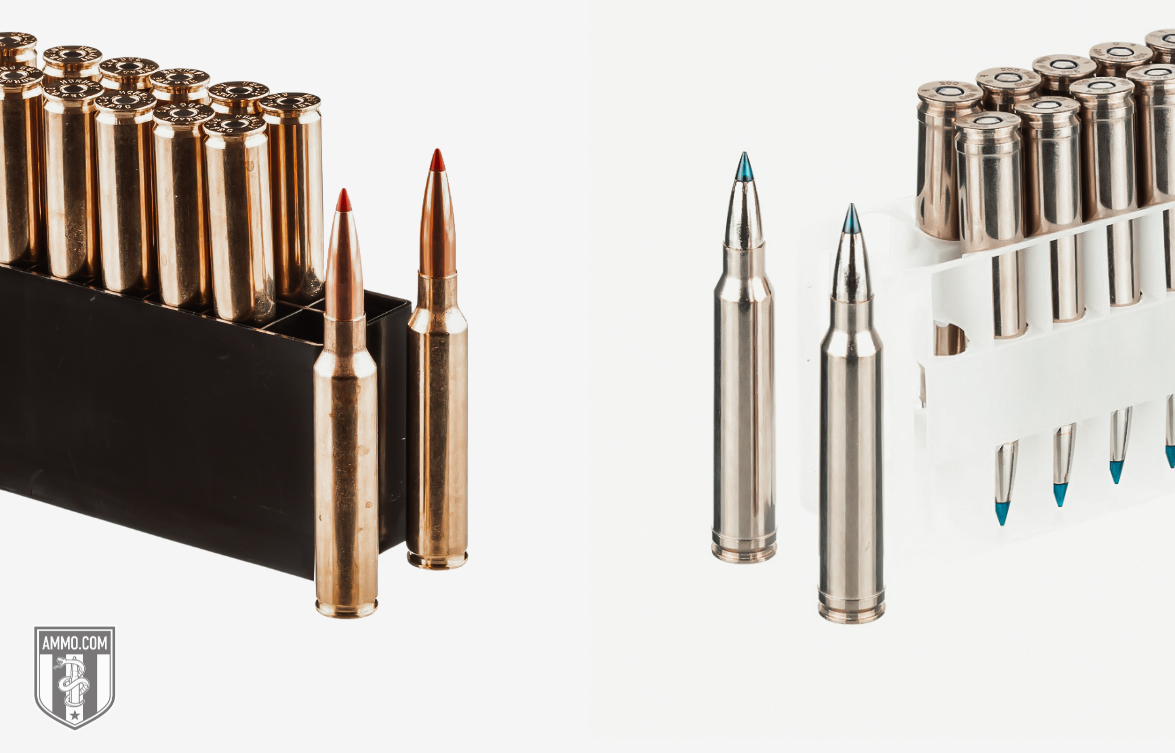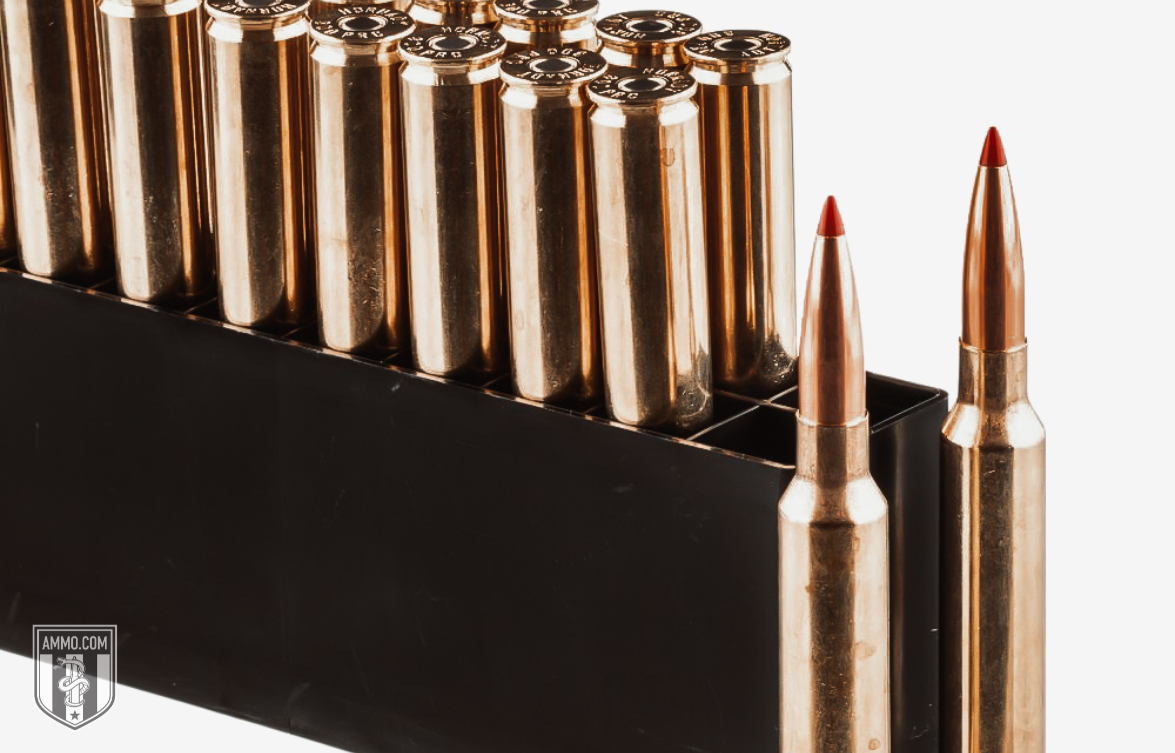300 RUM vs. 300 PRC: Long-Distance .30 Cal Cartridge Comparison

.30 caliber cartridges have dominated the minds and ranges of American shooters for over a century.
In recent decades, the 300 Remington Ultra Magnum (RUM) and 300 Precision Rifle Cartridge (PRC) have each been proposed as the ultimate solution for long-range shooting.
Each has some downfalls that make the other better in specific instances, however, which you’ll discover as you continue reading this 300 RUM vs. 300 PRC comparison article.
What Is the Difference Between 300 RUM and 300 PRC?
There’s no doubt that Jack Sparrow’s favorite cartridge would be the 300 RUM, simply for the name. But you're reading the wrong article if you’re basing which cartridge is better on a fictional character and circumstances.
To discover the difference between these two .30 caliber cartridges, we’ll compare and contrast them in real-world situations, evaluating recoil, trajectory, accuracy, stopping power, and overall cost.
But first, let’s see their similarities and differences in cartridge specifications.
Cartridge Specs
Let’s get into the nitty-gritty details of technical specifications for each cartridge.
The .300 RUM and .300 PRC were based on different parent cases, which explains why they use varying approaches to accomplish the same goal (launching a bullet WAY downrange). The 300 RUM is based on the .404 Jeffery, whereas the 300 PRC is based on the .375 Ruger.
They have the same bullet diameter (.308 in) and similar neck diameters (.344 in for the 300 RUM and .341 in for the 300 PRC), but the base diameter of the 300 RUM is expanded to .55 in contrast with .532 in of the 300 PRC.
The 300 Ultra Mag also has a longer case of 2.85 in compared to 2.58 in for the 300 PRC. The 300 PRC has a longer overall length of 3.7 in; 300 RUM overall length is 3.6 in.
The 300 RUM's larger base diameter and longer case mean its case capacity is 110.2 grains H2O, compared to the 300 PRC’s case capacity of 77 grains H2O. However, the cartridges have the same maximum pressure of 65,000 psi.

Now, let’s see how these similarities and differences translate into real-world performance, starting with recoil.
Recoil: 300 PRC vs. 300 RUM
Recoil is a crucial aspect to consider before choosing a new cartridge for target shooting or hunting. A rifle with lots of recoil is unpleasant to fire and indirectly affects a shooter's accuracy and efficiency (flinching as you fire, quickly realigning your sights with the target, etc.).
The recoil of a round is determined by the muzzle velocity (fps), propellant weight, rifle weight, and bullet weight. Felt recoil varies from shooter to shooter, making it unquantifiable. But recoil energy is measurable.
When fired from a 14.5 lb rifle, like the Barrett MRAD bolt-action rifle, a 300 PRC 225 grain Hornady ELD Match (ELD-M) bullet launched at 2,810 fps will have a free recoil energy of around 22 ft-lbs.
When fired from a 9 lb rifle, like the Remington 700 bolt-action rifle, a 300 RUM 230 grain Berger Hybrid bullet launched at 2,975 fps has a recoil energy of around 41 ft-lbs. This recoil is from a lighter rifle and heavier bullet, but the 300 RUM will generally have a heavier recoil than the 300 PRC (34.97 ft-lbs for the 300 RUM versus 32.42 ft-lbs for the 300 PRC).
While neither cartridge is easy on the shoulder, the 300 PRC wins this section and takes the early lead because it has less recoil.
Trajectory
Trajectory quantifies the bullet’s flight path to its target. It is an arch, often measured in inches of bullet drop. A flatter trajectory is preferred for long-distance shooting because the shooter makes fewer adjustments to remain accurate at varying distances.
When firing a Remington Premier Long-Range 215 grain bullet with a muzzle velocity of 2,180 fps, the 300 PRC projectile will drop -39 in at five hundred yards when zeroed in at 200 yards.
However, for the Remington Premier A-Frame 200 grain bullet with a muzzle velocity of 3,032 fps, the 300 RUM projectile will only drop -29.2 in at five hundred yards when sighted in at 200 yards. The 300 RUM will have a flatter trajectory than the 300 PRC due to the higher muzzle velocities with similar bullet weights.
The .300 Ultra Mag wins this section and ties up the comparison.
Accuracy: 300 Remington Ultra Magnum vs. 300 Precision Rifle Cartridge
Accuracy is tricky to analyze. Rifle design, barrel life, ammo consistency, shooter skill, and environmental conditions contribute to a cartridge’s accuracy.
Recoil also affects accuracy, especially when firing over longer ranges. Many shooters are more accurate with a rifle that has less recoil because they can focus more on their shooting fundamentals (breath control, trigger manipulation, not disturbing sight alignment) rather than worrying about how badly the shot is going to hurt their shoulder.
The trajectory affects a round's accuracy, as a flat trajectory requires the shooter to make less drastic adjustments as the distance increases.
In this instance, it’s a matter of picking your poison. Can you handle the extra recoil of the 300 RUM to take advantage of the flatter trajectory, or would you prefer the lower recoil of the 300 PRC?
This section is a tie because both cartridges are very accurate at long distances in the hands of a capable shooter.
Ballistic Coefficient
A projectile's ballistic coefficient (BC) measures how well a bullet resists wind drift and slices through the air. Said another way, it’s a numeric representation of a bullet’s aerodynamic capabilities. A high BC is preferred as the bullet will cut through the wind more easily, making it more accurate.
Generally, a sleeker, heavier bullet will have a higher BC as it’s more aerodynamic. It takes more force to disrupt the flight path of a heavier bullet than a lighter one. The BC varies from bullet to bullet within each cartridge.
The 300 PRC fires long, slender projectiles designed to have a high BC. The 300 PRC 212 grain Hornady ELD-X Precision Hunter has a BC of 0.663, while the Barnes 245 grain Extreme Outer Limits (EOL) has a ballistic coefficient of 0.807.
The 300 Remington Ultra Magnum also fires high-BC bullets. A Barnes 212 grain LRX BT has a BC of 0.705, but lighter projectiles like the 130 grain TSX BT have a BC of 0.340.
The 300 PRC wins this section, as it will generally utilize higher BC bullets.
Stopping Power: 300 RUM vs. 300 PRC

“Stopping power” is a term thrown around gun shops and forums to make you believe one cartridge is superior to another for defense or hunting situations. While things like energy transfer, penetration depth (sectional density), bullet size, and design matter, shot placement matters the most.
A poorly placed shot with a more powerful cartridge is less lethal than a well-placed shot with a less powerful cartridge. With that out of the way, does the 300 RUM or 300 PRC have more stopping power?
Neither cartridge lacks stopping power, but the 300 RUM tends to conserve energy in a slightly better downrange.
The 300 RUM wins this section by a slim margin.
Hunting
The 300 PRC and 300 RUM are often used to hunt big game animals. Neither cartridge is a good option for varmint or small game hunting and are frequently too powerful for whitetail deer, as they would destroy a large amount of tasty meat.
However, they excel at long-range hunting for mule deer, elk, moose, and bear in western states.
The 300 PRC is a more versatile round, as it’s less likely to destroy as much meat on a whitetail deer as the 300 RUM is, but only by a hair because it still carries a tremendous amount of energy downrange.
The 300 PRC wins this section because it’s slightly more versatile. It can hunt anything from whitetails to bears and everything in between.
Home Defense: 300 PRC vs. 300 RUM
I rarely recommend a rifle cartridge for home defense because it can over-penetrate the target and multiple walls. Like the 338 Lapua Magnum, these .30 caliber magnum cartridges can easily penetrate numerous walls, endangering your family and neighbors.
These cartridges are regularly used to shoot over one mile, so a shotgun or pistol cartridge is a much better option.
However, if I were forced to choose only between the 300 PRC and 300 RUM, I would grab the 300 PRC as it doesn’t carry as much energy downrange.
This section is a tie. I don’t recommend either for home defense.
Cost & Availability
In order to consistently shoot these two cartridges, you’ll need venture capital, a sponsorship, or deep pockets. Factory ammo is more expensive than the 300 Winchester Magnum (300 Win Mag), but rifles are similarly priced.
However, the 300 PRC cartridge tends to be more available and less costly than the 300 RUM.
No matter which cartridge you choose, both will be expensive, but the 300 PRC will be less so in the long run.
The 300 PRC wins this section because of its slightly less expensive ammo.
Reloading: 300 Rem Ultra Mag vs. 300 PRC
One way to save money on factory loads is to reload the spent brass. The initial cost to purchase the reloading equipment and supplies is high, but after that, you begin to rake in the savings.
Handloads are the perfect way to dial in the top-performing round for your rifle. Load development is key to maximizing your long-distance shooting capabilities.
There are a plethora of reloading information and supplies available for both cartridges, so this section is a tie.
Ballistic Charts
Another section for the numbers lovers, the ballistics of each cartridge! The team at Ammo.com has gathered each cartridge’s ballistics to help you quickly compare how each performs with various loads.
300 RUM Ballistics

300 PRC Ballistics

300 Remington Ultra Magnum Brief History
Remington released the .300 Ultra Magnum in 1999, which was very similar to the Canadian Magnum or Imperial Magnum cartridges as a long-range hunting cartridge.
It was designed to have a greater case capacity than the .300 Weatherby Magnum and .375 Ackley Improved. The 300 RUM has a rebated rim, which allows the cartridge to function in the Remington M700 action without increasing its bolt and bolt face diameter.
Many big game hunters in western states still prefer it, as they need the stopping power the 300 RUM provides at longer distances.
300 Precision Rifle Cartridge Brief History
The 300 Precision Rifle Cartridge was launched in 2018 because Hornady wanted to bridge the gap between the 338 Lapua Magnum and 300 Winchester Magnum for extreme long-range (ELR) shooters who attempted to reach past 1,500 yards without the shoulder-punishing recoil of the .338 Lapua.
The 30 Nosler and 300 Norma Magnum attempted this but fell slightly below the mark. Barrel life for these cartridges is painfully short. Hornady wanted to provide shooters with a cartridge that fires 200+ grain 0.308” diameter bullets while maintaining an acceptable barrel lifespan.
The 300 PRC embodies everything shooters love about the 6.5 Creedmoor and adapts it to the 30 caliber.
The 300 PRC is quickly becoming more popular in the long-range competition circuit and getting attention for military applications.
Frequently Asked Questions
The team at Ammo.com has gathered and answered some of the most commonly asked questions regarding the 300 RUM vs. 300 PRC.
Which Is Better For Elk Hunting, 300 PRC or 300 RUM?
The 300 PRC is better for elk hunting because it has lower recoil and a similar trajectory without sacrificing much stopping power.
Is 300 PRC smaller than 300 RUM?
Yes, the 300 PRC cartridge is smaller than the 300 RUM cartridge.
Is 300 RUM discontinued?
No, the 300 RUM is not discontinued.
Parting Shots: 300 RUM vs. 300 PRC
Congrats! You’ve finished the 300 RUM vs. 300 PRC comparison, and it’s time to tally up the results and crown a winner.
The 300 RUM won two sections (trajectory and stopping power). Three sections were a tie (accuracy, home defense, and reloading). The 300 PRC won four sections (recoil, BC, hunting, and overall cost).
While the 300 PRC won double the sections of the 300 RUM, it was often by a narrow margin because both cartridges are solid choices for long-distance shooting situations.
Remember to get all your ammo needs met at Ammo.com, where we offer competitive pricing and unbeatable customer service!
Ammo Comparisons
- .308 vs 5.56
- 6.5 Creedmoor vs .308
- .300 Blackout vs .308
- .300 Win Mag vs .308
- .243 vs .308
- .308 vs .30-06
- 7mm-08 vs .308
- .270 vs .308
- 7.62x39 vs .308
- .223 vs .308
- .338 Lapua vs .308
- .380 ACP vs 9mm
- .223 vs 5.56
- .300 Blackout vs 5.56
- 9mm vs 45 ACP
- 9mm vs 40 S&W
- .357 SIG vs 9mm
- 10mm vs 9mm
- 9mm vs 9mm Luger
- .243 vs .270
- .300 Win Mag vs .30-06
- .270 vs .30-06
- .40 vs .45
- 38 Special vs 357
- 9mm vs 40 vs 45
- 5.56 vs 7.62x39
- 338 Lapua vs .30-06
- .30-30 vs .30-06
- 300 PRC vs 338 Lapua
- .30-06 vs 7mm
- 300 Win Mag vs 338 Lapua
- 300 PRC vs 300 Win Mag
- 300 WSM vs 300 Win Mag
- 338 Win Mag vs 338 Lapua
- 12 Gauge vs 20 Gauge
- 10mm vs 357 Mag
- .30-30 vs 7.62x39
- 224 Valkyrie vs 22-250
- 17 HMR vs 22 Mag
- 7.62x39 vs .300 Blackout
- 45 ACP vs 45 Auto
- 45-70 vs 30-30
- 300 Blackout vs 223
- 357 Magnum vs 9mm
- 350 Legend vs 300 Blackout
- 224 Valkyrie vs 223
- 45 ACP vs 38 Super
- 6.5 Grendel vs .308
- 17 HMR vs 22 LR
- 10 Gauge vs 12 Gauge
- 22-250 vs 223
- 45 Colt vs 45 ACP
- 350 Legend vs 30-30
- 5.7x28 vs 223
- 5.7 vs 9mm
- 5.56 vs 5.7
- 22 vs 9mm
- Buckshot vs Birdshot
- 450 Bushmaster vs 308
- 450 Bushmaster vs 223
- Buckshot vs Slug
- 6.5 Grendel vs 5.56 vs 223
- 6mm ARC vs 6.5 Grendel
- 44 vs 45
- 458 SOCOM vs 5.56
- 357 vs 44
- 32 ACP vs 380
- 300 Win Mag vs 338 Win Mag vs 338 Lapua Mag
- 450 Bushmaster vs 458 SOCOM vs 50 Beowulf
- 6mm Creedmoor vs 6.5 Creedmoor
- TMJ vs FMJ
- 44 Special Vs 44 Magnum
- 45 90 vs 45 70
- 6.8 Western vs 6.8 SPC
- 50 Beowulf vs 50 BMG
- 26 Nosler vs 6.5 PRC
- 28 Gauge vs 410
- 6.8 SPC vs 5.56
- 6.8 SPC vs 6.5 Grendel
- 6.8 Western vs 7mm Rem Mag vs .28 Nosler
- 6.8 Western vs 6.5 Creedmoor
- 22 Hornet vs 223
- 6.8 Western vs 6.5 PRC
- .410 vs 12 Gauge
- .410 vs 20 Gauge
- 22 LR vs 22 Mag
- 6mm ARC vs 243
- 7mm-08 vs 270
- 243 vs 6.5 Creedmoor
- Nickel vs Brass Casing
- 204 Ruger vs 223
- 50 Beowulf vs 5.56
- 260 Remington vs 6.5 Creedmoor
- 6mm Remington vs 243
- 28 Nosler vs 300 PRC
- 50 Beowulf vs 50 AE
- 22 Nosler vs 22-250
- 450 Marlin vs 45-70
- 300 Win Mag vs 300 Norma
- 458 SOCOM vs 300 Blackout
- 38-55 vs 45-70
- 22 Hornet vs 22 LR
- 300 Norma vs 338 Lapua
- 338 Lapua vs 50 BMG
- 28 Nosler vs 300 Win Mag
- 28 Nosler vs 6.5 Creedmoor
- 204 vs 22-250
- 458 SOCOM vs 45 70
- 44 40 vs 45 70
- 6.8 SPC vs 6.5 Creedmoor
- 450 Bushmaster vs 30-06
- 7mm Rem Mag vs 300 Win Mag
- 30 Carbine vs 223
- 25-06 vs 30-06
- 26 Nosler vs 28 Nosler
- 16ga vs 12ga
- 30 06 vs 7.62 x54R
- 9mm Makarov vs 9mm Luger
- 350 Legend vs 223
- 30 Carbine vs 5.56
- 6.5x55 vs 6.5 Creedmoor
- 6.5 Creedmoor vs 270 vs 25-06
- M193 vs M855
- 450 Bushmaster vs 458 SOCOM
- 6.5 Grendel vs 6.5 Creedmoor
- 350 Legend vs 5.56
- .277 Fury vs 6.8 SPC
- 277 Fury vs 300 Win Mag
- 10mm vs .45 ACP
- 277 Fury vs 223
- 6.8 SPC vs 300 Blackout
- 6.5 PRC vs 6.5 Creedmoor
- 277 Fury vs 308
- 277 Fury vs 6.5 Creedmoor
- 350 Legend vs 450 Bushmaster
- 277 Fury Vs 5.56 NATO
- 10mm vs 40S&W
- 32 ACP vs 9mm
- 32 Special vs 9mm
- 8.6 Blackout vs 300 Blackout
- 30 Super Carry vs. 9mm
- 5.56 vs 9mm
- .50 Action Express vs 9mm
- 7.62x25 vs. 9mm
- 10mm vs 44 Magnum
- 300 Blackout vs 300 Win Mag
- 6.5 Grendel vs 300 Blackout
- 460 Rowland vs 10mm
- 300 RUM vs 300 PRC
- 300 Norma vs 300 PRC
- 45 GAP vs 45 ACP
- 7mm PRC vs 300 Win Mag
- 300 PRC vs 6.5 Creedmoor
- 300 PRC vs 308
- 357 SIG vs 357 Mag
- 7.62x39 vs 7.62x51
- 243 Win vs 223 Rem
- 30 Nosler vs 300 PRC
- 6.5 Creedmoor vs. 30-06 Springfield
- 450 S&W vs. 44 Magnum
- 6.5 Creedmoor vs. 300 Win Mag
- 454 Cassull vs. 45-70 Govt
- 454 Cassull vs. 44 Mag
- 7.62x54r vs. 308 Winchester
- 22 ARC vs. 223 Rem
- Subsonic vs. Supersonic Ammo



